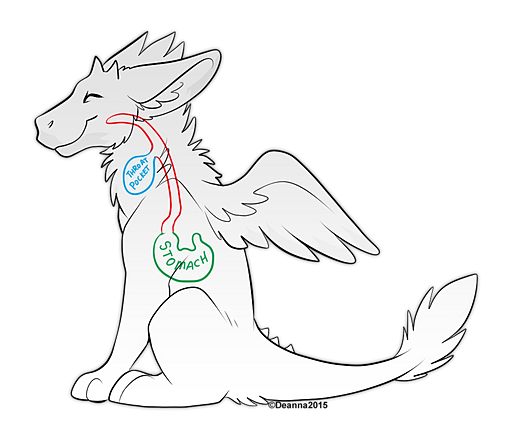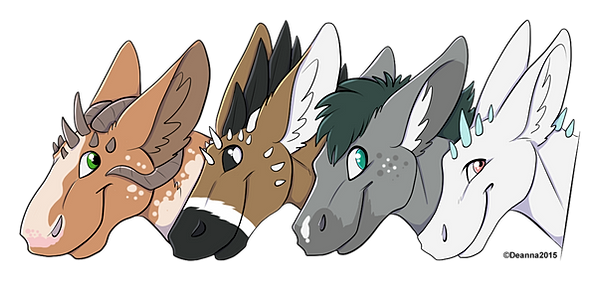@Blizz Of course.
- Last Seen: 8 yrs ago
- Joined: 9 yrs ago
- Posts: 213 (0.06 / day)
- VMs: 2
-
Username history
- xxrhoo 9 yrs ago
Status
Recent Statuses
9 yrs ago
Current
New account: see bio.
1
like
9 yrs ago
Remember where you got your faith. Cling to it.
1
like
9 yrs ago
Although, don't have your mind so open that your brains fall out.
2
likes
9 yrs ago
If you must have a loud voice, have a loud mind. If you must have a loud mind, open it.
1
like
9 yrs ago
Why not show the world all the positive things about your life instead of dwelling on the negative?
4
likes
Bio
Most Recent Posts
Rhoo is an Aquarius.
Rhoo Marhoon
RPG user xxrhoo is a young adult female from the United States. Her username originates from her fursona's name, Rhoo, with a throwback to the early-to-mid 2000's, when most Internet usernames had lowercase or capital x's in varying numbers before and after their name.
Rhoo is an angel dragon - she has blank eyes and eyebrows set to give her the expression of a cold stare, though past her outer shell of detachment, she is a ball of fun and happiness. Two clean, white, rounded horns no more than three inches tall protrude from the royal blue fur above her eyebrows. A horn sticks out just above her eyes in dead center, with more horns following behind it all the way to the edge of her long, furry tail. The tallest and sharpest horn curves backward from the crown of her head, surrounded by a sea of blood red hair. A bright blue patch in the shape of a diamond outlines her right eye. Underneath her left eye is a long, diagonal scar. Rhoo is five feet and five inches tall on two legs, and weighs roughly two hundred pounds at any given moment.
Rhoo watched her previous mate get slain by a large, deep blue angel dragon. He then turned to her and lunged, sinking powerful, hooked claws into her left eye so fiercely that the tip of them came out through her cheek below her eye, piercing through bone and all. As the dragon struggled to free his claws from her face, he slashed the other one, rendering her vision nonexistent and eyes useless. Eventually, the attacker's claws were detached as he pulled back with a force so intense that it could be considered miraculous that Rhoo's cheek was not ripped off of her face. As she lay in a confused, disoriented pile, a curiously colored fox came to her aid, effortlessly picking her up by the nape of her neck, for at the time she was no larger than a kitten.
At the time Rhoo meet Chillo Kilo the fox, she took the position of a sort of toddler in the community. With the help of his kin, Chillo managed to nurse Rhoo back to perfect physical health, though her vision would never return. Her once blue-green eyes faded white, not even a pupil visible. To this day, Rhoo suffers from mental and social restrictions. While she voices her every thought to Chillo, around others she speaks scarcely and uses Chillo as her voice. Chillo helps guide her around, and she has developed the ability to sense colors, but vaguely. With enough focus, Rhoo can connect to her magic abilities that were never properly taught to her, and shrink herself to the size of a fox kit. She had not yet learned to walk but on all fours when she was rescued, but Chillo and his family helped her learn, even with her vision impairment. Rhoo currently lives with Chillo, who has made a pact with her to be life-long mates despite their difference of species.
Though Rhoo had the option to regain her sight when she took on her current form through rebirth, she felt that it was an important part of her life story and decided to not change this trait.
Rhoo is not normally quick to trust. She speaks in third person, due to not being able to grasp the concept of the uses of "my, me, I, I'm." However, when referring to herself and at least one other person, she uses "we, us, our." When around someone she trusts, she talks excessively but slowly, yet excitedly. She is an overall happy and positive creature, even if she does not look that way at first glance.
Angel Dragons
For full official information on the original species Dutch Angel Dragons created by Ino, please visit this website.
Dutch Angel Dragons have a bone structure and physiology that is remarkably similar to that of a horse, specifically an Akhal-Teke. In fact because they are so similar, their souls are able to reincarnate on Terra as a horse to be alongside the living for a short lifetime. Angel Dragons that have done this throughout history prove to be some of the best companions- recognized as strong, courageous, and loyal to their riders and able to be quite formidable on the battlefield. Who knows, maybe you have touched an angel?
Dutch Angel Dragons have a very horse-like head with the exception of more forward-facing, full-color vision. They do share another specific trait to horses in their teeth- there is a large gap between the front teeth and the back sets. While dragons have developed slightly different shapes and lengths of their teeth to better suit their preferred food or look, they do not change the arrangement of their teeth. This is part of their trademark look.

Dutch Angel Dragons do not have a digestive tract, reproductive system, or even most standard organs such as the lungs or a heart. They do not have body fluids either. The only organs they possess is a throat pocket and a bottomless stomach that will absorb anything that is consumed to break it apart into pure energy. There is no waste matter from the food they consume so there is no colon or anus. Interestingly because of this energy consumption and storage, they do give off body heat and can feel temperature.

There are many different types of dragons ranging in size and shape- they can be as big as a bus or as small as a cat if they wanted. They have a remarkable ability to alter their appearance by "dying" like a phoenix and rebuilding themselves differently when they finally emerge from their egg. Since they are ageless, it is up to them to decide on how old they would like to look. The primary factor that plays a role in their appearance however is adaptations to their environment.


There are many types of tails these dragons might have, but most are long, furry tails with either feathers or manes at the tip to help with batting away pesky bugs or for flying. In some cases, they will have short docked tails that they were either born with or where torn off in a fight.
Sadly, once their tail is cut at any length it will not grow back, but feathers can. If a tail has been cut off at the base of the hindquarters, often the dragon will grow “butt feathers” in place of its tail. The dragon would have to go through the process of reincarnation to reclaim any lost limbs.
Some Dutch Angel Dragons have hooves, but most possess paws. The standard paws have four fingers/toes, no thumbs, a slight webbing between the digits, and semi-retractable claws on both hands and feet. They also have paw pads. Aquatic dragons may have a much more prominent webbing and under other kinds of conditions, there has been the development of scales.
The species cannot reproduce by normal standards because they lack reproductive organs... however, if two dragons were to pass away together to be “reborn”, their souls can merge into a unique combination of their life force and energies. Much like a magnetic energy field is created when two opposite forces come together, a spark of life forms from this powerful energy flow and synchronization as the two souls temporarily become one and then split again, a part of them is left behind to be conjoined as a new soul and it develops into a third egg. The new angel dragon that is born will have a mix of the two “parents” coat colors and physical traits. This will last for a hundred years before the dragon gains the ability to pass away by itself and change its appearance. It is also born as a blank slate and will need to grow and learn just like any other animal.
© 2007-2024